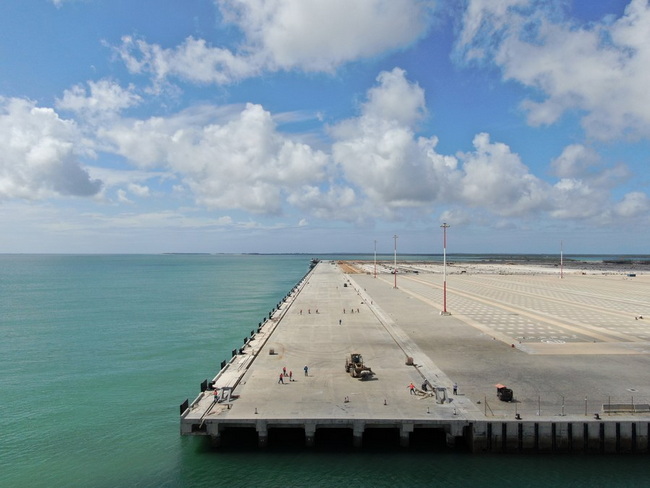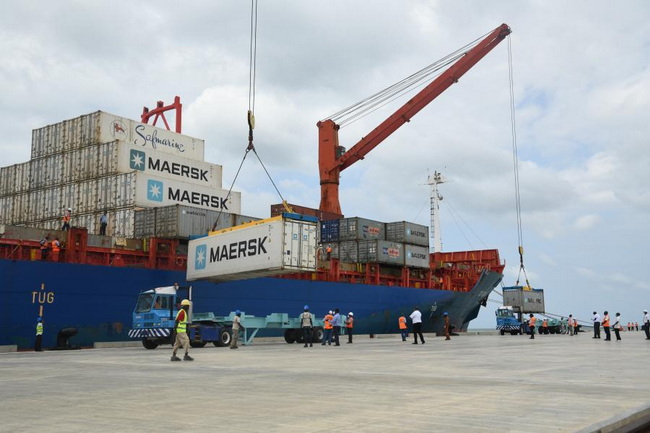Kenyans upbeat as Chinese-built Lamu port becomes operational

Aerial photo taken on May 16, 2021 shows an overview of the first berth of Lamu Port in Kenya. (Xinhua/Cui Weibao)
The inauguration of the first berth of the Lamu Port in May has raised some traders' hope and confidence in business. The port will become part of Kenya's bid to become the major trade hub in East Africa.
Igbal Abdi has been using Kenya's Mombasa port to import electronic goods for his clients who are based in the northeast region of the country.
The 55-year-old trader transports his cargo from the Mombasa port to Garissa town, a distance of 400 km, which is a tedious ordeal given the poor state of the highway road.
The inauguration of the first berth of the Lamu port in May, however, has raised Abdi's hope and confidence in business.
During the launch, Kenyan President Uhuru Kenyatta said the port will open up northern Kenya to the rest of the world and also provide a convenient gateway for South Sudan and Ethiopia.
Lamu port, about 240 km north of Mombasa along the Indian Ocean coastline, is the country's second commercial port and is only 240 km away from Garissa town.
Abdi told Xinhua Monday that he plans to begin using the Lamu port because it is closer to his destination as compared to the Mombasa port. "I hope to be able to deliver goods on a more timely basis," he noted.
China Communications Construction Company undertook the construction of the first of the 32 berths of the 310 billion shillings (about 2.9 billion U.S. dollars) facility. It can handle large vessels with a carrying capacity ranging from 12,000 twenty-foot equivalent units (TEUs) to 18,000 TEUs.
According to the Kenya Ports Authority (KPA), the first three berths will be financed by the government while the remaining 29 berths will be financed by the private sector.

Staff members unload cargo at the new harbor of Lamu Port in Kenya, on May 20, 2021. (Xinhua/Zhang Nanfang)
The facility is part of the regional Lamu Port-South Sudan-Ethiopia Transport corridor project that seeks to provide road, rail and pipeline links between the seaport and Kenya's northern neighbors of South Sudan and Ethiopia. The government will roll out lower charges for use of the facility for a temporary period in order to encourage more shippers to use the port.
Moses Ikiara, managing director of Kenya Investment Authority, said that a special economic zone will be built next to Lamu Port to manufacture goods for both local and international markets. Ikiara noted that the port facility is an ideal location to attract investments due to its proximity and convenience to the international markets.
Larry Mugambi, an importer, is also excited about the prospects of using the Lamu port to bring goods into the country. Mugabi, 50, currently uses the port of Mombasa as a gateway to deliver his goods to Isiolo town 700 km away. He noted that by using Lamu port, he will save both costs and time as the distance between Lamu to Isiolo is only 470 km.
Abdul Mohammed, who is based in Garissa, is also keen to utilize the port in order to export his livestock to overseas markets. Mohammed told Xinhua that transportation of his animals to the port of Lamu will also result in higher profits due to the shorter distance.
As a cornerstone of the Kenyan government's Vision 2030 development plan, it is now branded as a "game-changer" project. It aims to integrate marginalized northern Kenya into the Kenyan economy and the nation. There are also plans to establish numerous industrial areas along the corridor.


